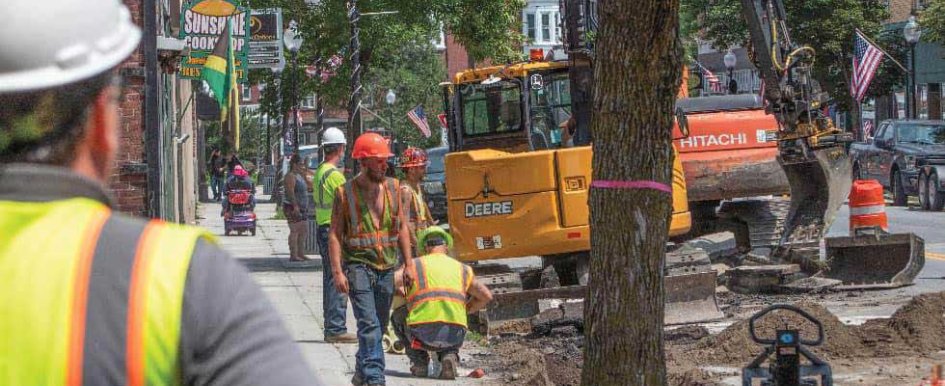
B.U.R. Construction’s commitment to technology is featured prominently in its latest downtown revitalization project. From heavy equipment fitted with specialized attachments and GPS capabilities to the systems used to bid on and subsequently win the job, technology is enabling the company to get more work, and get that work done more efficiently than ever before.
“We were using Excel and a lot of Post-it notes, scrap paper and, in some cases, even napkins,” said Tim St. Pierre, founder and co-owner of the company, describing the contractor’s approach to bidding prior to the adoption of estimating software in 2020. “We were putting out more and more bids, and it became too time consuming to do it the old-fashioned way, so we made a coordinated effort this past year to find a better solution,” he said.
B.U.R., which stands for bridges, utilities and roads, started in 2005 in Newport, New Hampshire, by St. Pierre and his brother, Jesse. They had no employees when they started the company, but they also had no reservations about branching out and expanding their business — after first gaining experience from the paving and excavating company their father continues to operate to this day. B.U.R. has grown exponentially over the last 10 years, working primarily as a general contractor on department of transportation (DOT) projects in New Hampshire and Vermont.
“The only way we can continue to grow is by putting estimates out more quickly,” said St. Pierre. “We don’t want to add overhead in order to do that, so our conscious choice was to add estimating software.”
The Software Advantage
Prepopulated cost information is a foundational concept of specialized software for estimating. The best applications give estimators flexibility to organize resource databases, templates and cost structures according to their specific needs and to use them in a logical way when building bids.
Having crews, employees, equipment and materials already built in has been a timesaver for B.U.R. “Getting everything entered on the front end was time-consuming, but once it’s entered, pulling up the information is a breeze,” said St. Pierre. As a result, the company now turns out two to three times as many bids as it previously could.
Accuracy and detail are important too. St. Pierre says Excel spreadsheets are great for summary estimating but they don’t give him the detail and flexibility he needs to zero in on specific costs, distribute profit and overhead to individual line items to offset risk and be 100% confident in aggressive bid numbers.
“You could bid any job in summary in Excel and put big numbers in and be safe, but specialized software lets you drill down and know where your margins could be and how you could win,” said St. Pierre. “That’s important when you really want to win a job, and when you need to be as competitive as possible on local and regional jobs like the ones we thrive on.”
B.U.R. also relies on special capabilities within the estimating software to streamline comparison of bids from subcontractors.
St. Pierre pointed out the temporary water supply lines as an example on the downtown revitalization project in New Hampshire.
“We were able to quickly and easily compare bids from subcontractors as well as our own costs for self-performing that part of the project and determine that it was more profitable to do the work ourselves,” he said. “With spreadsheets, we might not have done that review due to the complexity and time required.”
Tracking Performance & Profit
St. Pierre has also implemented new software for performance tracking. He says having estimating software that is unified with the field software amplifies the benefits of each individual application.
“When we win a job and turn it over to our field team, it’s almost like baking a cake,” he said. “We have the detailed recipe, and we can hand that over to a superintendent to show exactly what was put into the bid right down to the gallons of gasoline for each line item.”
Managers in the field see a level of detail in the bidding that they never saw before. That knowledge allows them to provide what St. Pierre describes as a second set of eyes, often suggesting improvements in how the job could be built even after the bid is won.
St. Pierre describes himself as “kind of old school,” but says using the new software was easy for him to pick up. He credits the logic and interfaces of the software and the effective training and support.
“It’s so user friendly that we’re pretty much able to figure it out and rarely have to call tech support, but when we do, we always get an immediate response and the answers we need,” he added.
Integration with accounting is another advantage that improves accuracy and saves time by eliminating redundant data entry.
“I would disagree strongly with companies that think they might be too small to benefit from software platforms designed for estimating, field tracking and other operational workflows,” St. Pierre said. Beyond the software itself, he says experience, ideas and training from the software supplier can be extremely valuable.
“As a relatively small contractor, we only know what we’ve experienced, but a good construction software supplier can provide a wide array of best-practice experience,” he said. “That expertise and training has helped us make our processes better and to maximize the benefits of the software.”
